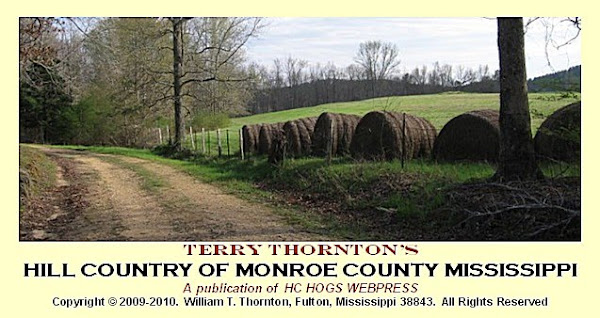by Terry Thornton
email: hillcountrymonroecounty@gmail.com
email: hillcountrymonroecounty@gmail.com
Smithville, Mississippi, is a small town located just east of the Tombigbee River in north-central Monroe County. Near the Itawamba County border, Smithville is within the "new part" of Monroe County because when the original county was formed, the land around Smithville was outside the United States. Then, the flat wooded land was in Indian Nation. Click map below for a larger view.
Prior to about 1835, the international boundary separating the two nations was along the Gaine's Trace, a horse path which became known as the Old Indian Treaty Boundary. That line shows clearly on all modern maps because the survey of the original county stopped at the boundary. See the county road map, for example, a copy of which is available online at www.goMDOT.com
Smithville was three miles north of that boundary --- and the official beginnings of Smithville came only after the mid-1830s when the United States and Monroe County Mississippi expanded westward and northward. But there seems to have been some trade with the Indians in the vicinity of current-day Smithville prior to that date.
According to information cited by W.A. Evans in Mother Monroe, Miss Harmon, late of Smithville, stated that an Indian trading store existed probably for ten or more years before Smithville was established putting such an store there circa 1826. Miss Harmon and Dr. Evans identified the store as that of "Charles Hedgepath."
It is known that Charles Hedgepath/Hudspeth received a license for a mill on Weaver's Creek in the area just south of Cotton Gin Port in the mid-1820s. Hudspeth owned property in old Monroe County which straddled Weaver's Creek near Becker.
It is also known that Hudspeth and John Ederington who owned property in and around Cotton Gin Port established the Hudspeth/Ederington Trading Post. But the location of that trading post has been difficult to determine. It is possible that the trading post of Hudspeth/Ederington is the same trading post as the one mentioned by Harmon and Evans.
Further, it is known that after the boundary was moved north and west John Ederington received land patents for property just east of current-day Smithville in 1838, Section 34 (along today's Jug Shop Road near Springfield Cemetery), and in 1844, Section 32 (for lands lying across Mill Creek). This Mill Creek was once known as Stegall's Mill Creek. See the map above for the location of these two sections.
After the county was extended in the mid-1830s, Smithville began as a small town growing up around a crossroads and the store/residence of William Smith. In more recent times, the old Smith lot on the corner of Hatley/Athens Road and Highway 25/Cotton Gin Port Road was the site of the Stegall House and cemetery. Today a service station and general store occupies the lot --- the cemetery covered over and the grave markers removed to a cemetery in Itawamba County.
Most researchers, however, trace "official" Smithville's beginnings to that corner in downtown upon which the William Smith log cabin and store was located. "Unofficial" Smithville probably began as a trading post in the Indian Nation.
The description of Smithville by Dr. Evans is most interesting and accurate. He states, "Smithville is located on a bit of level ground, called by the pioneers, Flat Woods [emphasis added], between Stegall's Mill Creek on the east, the Tombigbee on the west, and a low swampy area on the north."
That "low swampy area on the north" is Bull Mountain Creek and Bottom --- and is now part of the drainage and impoundment area of a lake on the Tennessee-Tombigbee River Waterway. Highway 25 continues north of town crossing the swampy area and Bull Mountain Creek which is the boundary between Monroe and Itawamba County.
Below are three photographs of Smithville and a link to a video of a drive through Smithville. Oh, locals usually pronounce the name of their town as "Smiffle." Click photographs for a larger image.


Landmark painted advertisement on side of the old Nabors Brothers store.
Nabors Brothers Store is now an antique store. When you can catch the store open, it is worth the effort to stop and look at some of the wonderful artifacts from old Smithville on display including some old store ledgers.
Smithville Hardware still does a brisk business --- a hardware store has been located on that corner for many years. A new landmark, a gazebo and small park area is being developed as show above.
To view a short video of a drive through Smithville on September 22, 2009, click
SOURCES and SUGGESTED READING:
Boyd, Gregory A., Family Maps of Monroe County, Mississippi. Norman, Oklahoma: Arphax Publishing Company, 2007, Map Group 4, pages 60 - 63.
Bureau of Land Management, General Land Office Records, available at http://www.glorecords.blm.gov
Evans, W.A., Mother Monroe. Hamilton, Mississippi: Mother Monroe Publishing, 1979, pages 52 and 53.
Hudspeth and Ederington Information. Kari Carpenter, Pioneer, California. Exchange of a series of emails with Terry Thornton, Fulton, Mississippi, August 11 - September 19, 2009.
Monroe County Mississippi Official Highway Map, available at Mississippi Department of Transportation, www.GOMDOT.com
Pierce, Miss Jessie. History of Smithville. Amory, Mississippi: L.H. Pierce, 1958. Reprinted at Terry Thornton's Hill Country of Monroe Country, Volume 1 CD, Numbers 756 - 762, December 12, 2008.
Photographs of Smithville Mississippi, September 6, 2009. Terry Thornton, Fulton, Mississippi. All Rights Reserved.




No comments:
Post a Comment